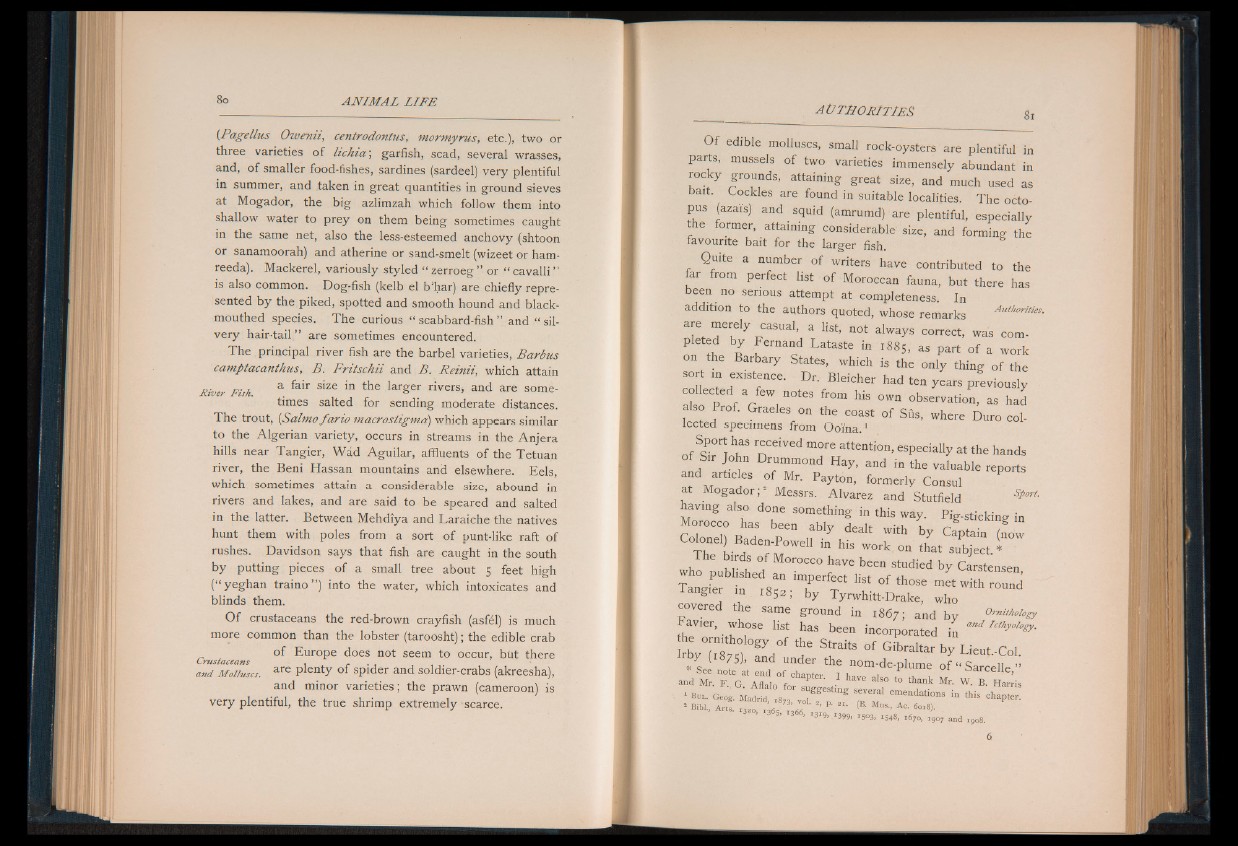
{Page¿¿us Owenii, centrodontus, mormyrus, etc.), two or
three varieties o f ¿tchia; garfish, scad, several wrasses,
and, of smaller food-fishes, sardines (sardeel) very plentiful
in summer, and taken in great quantities in ground sieves
at Mogador, the big azlimzah which follow them into
shallow water to prey on them being sometimes caught
in the same net, also the less-esteemed anchovy (shtoon
or sanamoorah) and atherine or sand-smelt (wizeet or ham-
reeda). Mackerel, variously styled “ zerroeg ” or “ cavalli ”
is also common. Dog-fish (kelb el b’har) are chiefly represented
by the piked, spotted and smooth hound and blackmouthed
species. The curious “ scabbard-fish” and “ silvery
hair tail ” are sometimes encountered.
The principal river fish are the barbel varieties, Barbus
camptacanthus, B . F ritschii and B , Reinii, which attain
River Fish a ^a’r s'ze larger rivers, and are sometimes
salted for sending moderate distances.
The trout, {Saimofario macrosiigma) which appears similar
to the Algerian variety, occurs in streams in the Anjera
hills near Tangier, Wad Aguilar, affluents of the Tetuan
river, the Beni Hassan mountains and elsewhere. Eels,
which sometimes attain a considerable size, abound in
rivers and lakes, and are said to be speared and salted
in the latter. Between Mehdiya and Laraiche the natives
hunt them with poles from a sort o f punt-like raft of
rushes. Davidson says that fish are caught in the south
by putting pieces of a small tree about 5 feet high
(“ yeghan traino ” ) into the water, which intoxicates and
blinds them.
Of crustaceans the red-brown crayfish (asfel) is much
more common than the lobster (taroosht); the edible crab
of Europe does not seem \sTUStCLC6CLn V to occur, but there
and Molluscs. are Plenty of spider and soldier-crabs (akreesha),
and minor varieties; the prawn (Cameroon) is
very plentiful, the true shrimp extremely ■ scarce.
AU TH O R IT IE S 81
O f edible molluscs, small rock-oysters are plentiful in
parts, mussels of two varieties immensely abundant in
rocky grounds, attaining great size, and much used as
bait. Cockles are found in suitable localities. The octopus
(azais) and squid (amrumd) are plentiful, especially
he former, attaining considerable size, and forming the
favourite bait for the larger fish.
Quite a number of writers have contributed to the
ar from perfect list of Moroccan fauna, but there has
been no serious attempt at completeness. In
addition to the authors quoted, whose remarks f l l P
K X f f l i a liSt’ n0t alwa^s correct, was com.
pleted by Fernand Lataste in 1885, as part o f a work
on the Barbary States, which is the only thing o f the ■ I ¡88111 Dr- t i d i e r had ten years previously
ollected a few notes from his own observation, as had
also Prof. Grades on the coast o f Sus, where Duro collected
specimens from Ooi'na.1
Sp° rt has H H more attention, especially at the hands
of Sir John Drummond Hay, and in the valuable reports
and articles of Mr. Payton, formerly Consul
at Mogador;2 Messrs. Alvarez and Stutfield Sport
having also done something in this way. Pig.sticking in
Morocco has been ably dealt with by Captain taow
Colonel) Baden-Powell in his work on that subject *
The birds o f Morocco have been studied by Carstensen
who published an imperfect list o f those me. with round
Tangier in 1852; by TyrwhitbDrake, who
covere the same ground in 1 8 6 7 ; and by Ornithology
r avier, whose list has been incorporated in and Icthy°losy
I r L r 7h0 Ogy, Of E l StmitS ° f Gibraltar by Lieut.-Col.
* S . l note at “ „ " l a p L 1 " ° m -d e - p l " m e O f “ S a r c e l l e . "
and Mr. F. G Aflalo fnr ’ J tC> thank Mr- w - B. Harris
■ ‘ Bur. «Mill emendations in this chapter
= Biblp Arts. - (B- Mus., Ac. 6OI8). . 3 5, 3 6, 1319, .1399, 1503, 1548, 1670, 1907 and 1908.